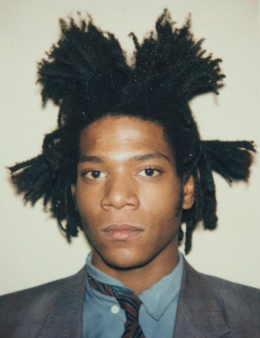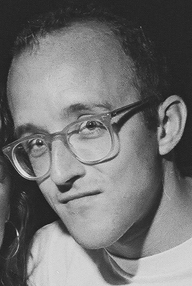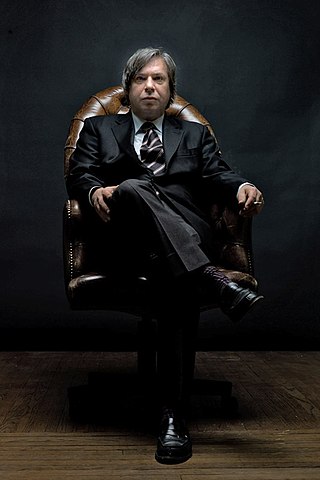
Andy Warhol was an American visual artist, film director and producer. A leading figure in the pop art movement, Warhol is considered one of the most important artists of the 20th century. His works explore the relationship between artistic expression, advertising, and celebrity culture that flourished by the 1960s, and span a variety of media, including painting, sculpture, photography, and filmmaking. Some of his best-known works include the silkscreen paintings Campbell's Soup Cans (1962) and Marilyn Diptych (1962), the experimental film Chelsea Girls (1966), and the multimedia events known as the Exploding Plastic Inevitable (1966–67).

Jean-Michel Basquiat was an American artist who rose to success during the 1980s as part of the Neo-expressionism movement.

Keith Allen Haring was an American artist whose pop art emerged from the New York City graffiti subculture of the 1980s. His animated imagery has "become a widely recognized visual language". Much of his work includes sexual allusions that turned into social activism by using the images to advocate for safe sex and AIDS awareness. In addition to solo gallery exhibitions, he participated in renowned national and international group shows such as documenta in Kassel, the Whitney Biennial in New York, the São Paulo Biennial, and the Venice Biennale. The Whitney Museum held a retrospective of his art in 1997.
Stephen Sprouse was an American fashion designer and artist. He is credited with pioneering the 1980s mix of "uptown sophistication in clothing with a downtown punk and pop sensibility".

Ann Magnuson is an American actress, performance artist, and nightclub performer. She was described by The New York Times in 1990 as "An endearing theatrical chameleon who has as many characters at her fingertips as Lily Tomlin does".

Kenny Scharf is an American painter known for his participation in New York City's interdisciplinary East Village art scene during the 1980s, alongside Jean-Michel Basquiat and Keith Haring. Scharf's do-it-yourself practice spanned painting, sculpture, fashion, video, performance art, and street art. Growing up in post-World War II Southern California, Scharf was fascinated by television and the futuristic promise of modern design. His works often include pop culture icons, such as the Flintstones and the Jetsons, or caricatures of middle-class Americans in an apocalyptic science fiction setting.
The Pop Shop was a store owned by pop artist Keith Haring. Haring opened the first Pop Shop in New York City in 1986 and later one in Tokyo. Haring viewed the Pop Shop as an extension of his work. It served to fulfill the artist's desire to make his iconic and beloved imagery accessible to the widest possible range of people both during his lifetime and posthumously through the Keith Haring Foundation. Every area of the store was devoted to Haring's work including floor-to-ceiling murals. The logo for the Pop Shop was a star with "Pop Shop" in the center.
Eric Haze is an American artist, graphic designer and art director.

Donald Joseph White, "DONDI" was an American graffiti artist.

Tseng Kwong Chi, known as Joseph Tseng prior to his professional career, was a Hong Kong-born American photographer who was active in the East Village art scene in the 1980s. He is the brother of dancer/choreographer Muna Tseng.

George Condo is an American visual artist who works in painting, drawing, sculpture and printmaking. He lives and works in New York City.

Steven Alan Kaufman was an American pop artist, fine artist, sculptor, stained glass artist, filmmaker, photographer and humanitarian. His entry into the world of serious pop art began in his teens when he became an assistant to Andy Warhol at The Factory studio, who nicknamed him "SAK". Kaufman eventually executed such pieces as a 144-foot-long canvas which later toured the country.

The AIDS pandemic began in the early 1980s and brought with it a surge of emotions from the public: they were afraid, angry, fearful and defiant. The arrival of AIDS also brought with it a condemnation of the LGBT community. These emotions, along with the view on the LGBT community, paved the way for a new generation of artists. Artists involved in AIDS activist organizations had the ideology that while art could never save lives as science could, it may be able to deliver a message. Art of the AIDS crisis typically sought to make a sociopolitical statement, stress the medical impact of the disease, or express feelings of longing and loss. The ideologies were present in conceptions of art in the 1980s and are still pertinent to reception of art today as well. Elizabeth Taylor, for example, spoke at a benefit for AIDS involving artwork, emphasizing its importance to activism in that "art lives on forever". This comment articulates the ability of artwork from this time to teach and impact contemporary audiences, post-crisis. This page examines the efforts of artists, art collectives, and art movements to make sense of such an urgent pandemic in American society.
Queer art, also known as LGBT+ art or queer aesthetics, broadly refers to modern and contemporary visual art practices that draw on lesbian, gay, bisexual, transgender, and various non-heterosexual, non-cisgender imagery and issues. While by definition there can be no singular "queer art", contemporary artists who identify their practices as queer often call upon "utopian and dystopian alternatives to the ordinary, adopt outlaw stances, embrace criminality and opacity, and forge unprecedented kinships and relationships." Queer art is also occasionally very much about sex and the embracing of unauthorised desires.

A Pile of Crowns for Jean-Michel Basquiat is a 1988 painting created by American artist Keith Haring. The artwork was made to memorialize his friend, artist Jean-Michel Basquiat. It depicts a towering pile of Basquiat's trademark crowns.

Todos Juntos Podemos Parar el SIDA is a mural created by American artist and social activist Keith Haring in 1989. The mural was painted to raise awareness to the AIDS epidemic. It is located next to the Museu d'Art Contemporani de Barcelona museum in the El Raval neighbourhood of Barcelona.

Andy Mouse is a series of silkscreen prints created by American artist Keith Haring in 1986. The character Andy Mouse is a fusion between Disney's Mickey Mouse and Andy Warhol. The series consists of four silkscreen prints on wove paper, released in an edition of 30 per colorway, all signed and dated in pencil by Haring and Warhol.
The Keith Haring Mural is a mural created in 1984 by American artist Keith Haring. Located in Collingwood, Melbourne, the mural was added to the Victorian Heritage Register in 2004 for its historical, aesthetic and social significance to the State of Victoria.
Unfinished Painting is a 1989 painting by American artist Keith Haring. It is a 100 cm by 100 cm acrylic painting on canvas piece, recognizable by the large swath of canvas left exposed. It is known as one of Haring's final paintings before his 1990 death from AIDS-related complications at the age of 31. From April 27 to September 8, 2024, the piece was on tour with the "Keith Haring: Art Is for Everybody" exhibit at the Walker Art Center.













